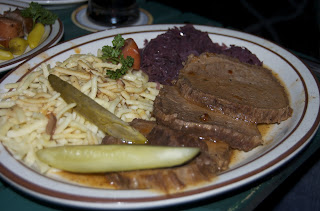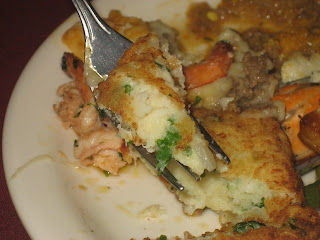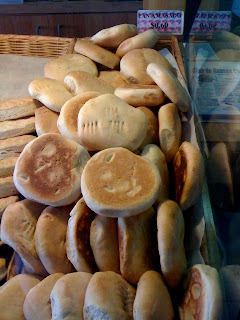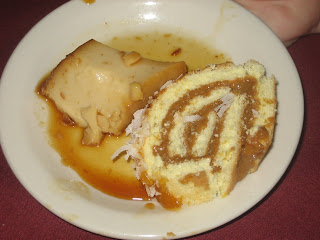One of the -stans in Stanland, Uzbekistan is nestled in between Kazakhstan & Turkmenistan.
Uzbek restaurants are in short supply around Los Angeles, and the only one I could find mention of has closed. Fortunately, I have a pal who: 1. has been to Uzbekistan and spent a lot of time in that part of the world; 2. is conversant in the region’s languages; and 3. holds a passion for the region’s food and culture. It doesn’t hurt that he has written enough books and newspaper copy on the area’s cuisines to fill at least one bookshelf.
So when Charles Perry, late of the Los Angeles Times food section, volunteered to cook an Uzbek meal at our house, Himself and I couldn’t say “YES!” fast enough. While Charlie developed a menu to showcase the country’s staples and flavors, we set a date and invited guests.
Charlie discusses the menu while Chuck mixes herbal champagne cocktails he designed to complement the evening’s fare.
My cocktailian pal Chuck Taggart brought the mixings for pre-dinner cocktails. We were his happy guinea pigs as he concocted an intriguing blend of champagne, Zubrowka, Bison Grass Vodka, bitters and various tinctures he’d made from things like lemongrass, black pepper, allspice and clove. As he carved long, golden twists from a couple of voluptuous lemons, a citrusy mist burst forth and perfumed the entire house with its bright essence.
…with a twist. And check out that assortment of tincture bottles.
Two of our guests, Grace and Bob, popped into Silver Lake Wine to pick up some wine for the meal. When they told the guy behind the counter they were having Uzbek food, he rattled off a number of Uzbek dishes, most of which were on our menu, and knew precisely which wines would pair best with them. He sent them out the door with two wines, one from Bosnia and one from France, both of which worked beautifully.
Чалоб or Chalob, a cold yogurt soup
Our starter was chalob, a cold yogurt soup, a combination of full-fat plain yogurt with chopped onions, radishes, celery, green onions, cilantro and mint, and diluted with just enough water to give it the consistency of a stew, albeit a cool, fresh one. I think I’ll be making chalob in large quantities next summer. It’s healthy and satisfying. I’d say go ahead and indulge in the full-fat yogurt—the texture is so much better. And all those raw veggies help mitigate the effects of the full fat.
Уй Нони or Ui Noni, a flatbread
Accompanying the soup–and everything else–was ui noni, a flatbread that’s similar to the Indian naan (you can tell from the name if not from the shape). It’s a basic lean bread that’s typically slapped onto the inside wall of a tandir to bake. But having no such earthen baking vessel, Charlie had to make do with a sheet pan and a regular old kitchen oven. The results were a good, hearty bread with a peculiar design stamped into them.
Ui Noni and a couple of chekiches
In Uzbekistan, bakeries identify their bread by stamping each piece with an instrument that produces a distinctive pattern. The chekich is a carved handle with metal pins or nails set into it that is used for this chore. Charlie noted that these instruments, when used for a long time, eventually degrade as the pins get driven back into the handle and sometimes bend in different angles. Interestingly, the gradual changes in the design on the bread that are the result of an aging chekich bring a sense of trust to regular customers, who would become suspicious of a piece of bread bearing the old familiar design if it was made by a new punch—proof that brand loyalty extends beyond packaging!
Charlie brought a handful of chekiches to show us,
each with its own distinctive pattern of pins.
Ошковок Манти or Oshqowoq Manti, steamed pumpkin dumplings
These scarab-shaped dumplings were amazing to look at and of course, seriously tasty. The stuffing is a mixture of cooked pumpkin (you can use acorn squash) and browned onion, seasoned with salt, black pepper, cinnamon and turmeric. A spoonful of this mixture is placed in the center of a square of homemade pasta, which is then folded into this distinctive shape. Then the dumplings are buttered and steamed. You can see how large these are by comparing them to the size of my hand on the edge of the plate.
detail of a dumpling topped with sour cream
Ковурма Лалов or Qowurma Palow (fried pilaf)
The main dish was a palow or pilaf with rice, beef, onions and carrots. If he’d been making this dish in Uzbekistan, Charlie would have fried the meat in lamb’s tail fat and added in some barberries, a couple of items you just can’t pick up at Trader Joe’s (although if you can find a Persian market, they might carry the barberries, which are also known as zereshk). Still, the palow was good stuff, touched with red pepper and redolent of cumin.
Анор ва Лиёз Салатаси or Anor wa Piyoz Salatasi, a pomegranate & onion salad
The pomegranate and onion salad was one of those dishes you really have to taste to believe. Essentially, it’s just those two items tossed in a bowl. What makes this salad work is that the onions are sliced really thinly, which opens up the maximum number of the cells filled with tear-inducing enzymes, and then rinsed thoroughly. This washes away what makes onions so difficult to eat raw in large quantity. You’re left with some pretty sweet tasting stuff. The pomegranate seeds add a little more sweetness, while perking up the salad with a jolt of tartness and astringency.
Тулоб or gulob, a fruit drink
We drank our dessert of gulob, a purée of apricots, apples, grapes, berries—essentially any fruit you have on hand—with a little sugar and some vanilla or saffron to enrich the flavor and diluted with water to drinkability. Gulob is another dish we’ll be adding to our list of great finds from our 52 Cusines experience. It was a refreshing end to our Uzbek meal.





























